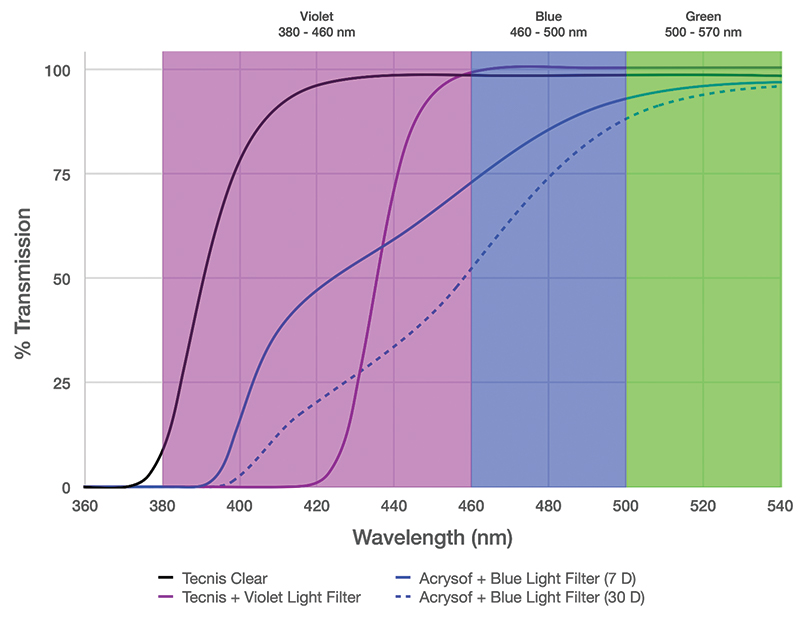EVALUATING CHROMOPHORE IOLS
Visual quality and function. Within the visible light spectrum, high-energy short-wavelength light causes greater scatter (contributing to dysphotopsias), induces more chromatic aberration,2 and causes more visual discomfort. Chromophore IOLs can improve night vision symptoms by reducing light scatter.3 However, because blue light plays an important role in scotopic vision,4 chromophores that filter blue light can have a negative effect on vision in low light. Color perception can also be affected.
Circadian rhythm. The circadian rhythm is important for cognition, sleep, metabolism, and many other aspects of physiological health. It is entrained by nonvision-related cells in the retina, known as intrinsically photosensitive retinal ganglion cells. When these cells are stimulated by blue light, particularly in the range of 460 to 480 nm, they release melanopsin, which suppresses melatonin, the hormone driving circadian rhythm function.4,6 Studies have shown that the implantation of a clear IOL improves sleep quality and cognition, but reports have been inconsistent regarding the impact of blue-light–filtering chromophore IOLs on the circadian rhythm.
TRADEOFFS
As with many aspects of IOL design, the ideal transmission profile of chromophores involves a balance of tradeoffs in visual quality and function, phototoxicity, and circadian rhythm. No chromophore is ideal under all circumstances. I would argue that the best approach is to block wavelengths that are known to be detrimental and to transmit wavelengths that may be beneficial. Because of an overlap in the benefits and drawbacks of high-energy wavelengths, it is helpful for a chromophore to have a steep cutoff in the transmission spectrum (Figure).

Figure. Transmission spectra of various IOLs, including those with violet-light– and blue-light–filtering chromophores. Note the steep IOL power–independent cutoff of the violet-light filter versus the broad cutoff of the blue-light filter, which moderately reduces the transmission of important blue light while allowing the transmission of high-energy phototoxic violet light, especially in lower-diopter IOLs.
1. Chang D, Pastuck T, Rosen R, et al. Violet and Blue Light: Impact of High-Energy Light on Vision and Health. J Ophthalmic Stud. 3(2): dx.doi.org/10.16966/2639-152X.119.
2. Zhao H, Mainster MA. The effect of chromatic dispersion on pseudophakic optical performance. Br J Ophthalmol. 2007;91:1225-1229.
3. Hammond BR Jr, Renzi LM, Sachak S, Brint SF. Contralateral comparison of blue-filtering and non-blue-filtering intraocular lenses: glare disability, heterochromatic contrast, and photostress recovery. Clin Ophthalmol. 2010;4:1465-1473.
4. Mainster MA. Violet and blue light blocking intraocular lenses: photoprotection versus photoreception. Br J Ophthalmol. 2006;90(6):784-792.
5. Marie M, Bigot K, Angebault C, et al. Light action spectrum on oxidative stress and mitochondrial damage in A2E-loaded retinal pigment epithelium cells. Cell Death Dis. 2018;9(3):287.
6. Brøndsted A, Lundeman J, Kessel L. Short wavelength light filtering by the natural human lens and IOLs—implications for entrainment of circadian rhythm. Acta Ophthalmol. 2013;91:52-57.

